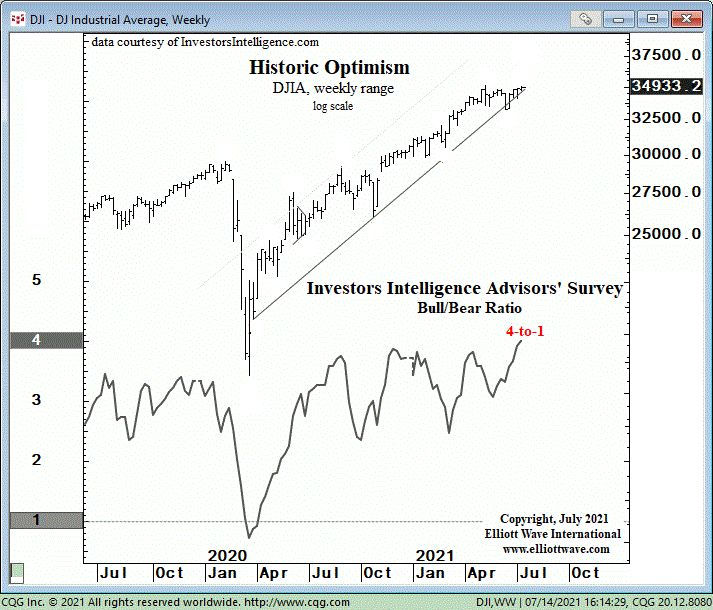Most stock market investors get fooled at major price turns. Why? Because a bottom never feels like a bottom and a top never feels like a top – how many bears could you count in 2007, right before stocks tanked and the Great Recession followed? This idea was embodied by the quote attributed to Barron Rothschild, an 18th-century member of the Rothschild banking family. He said that “the time to buy is when there’s blood running in the streets.”
Rothschild made a fortune buying in the panic that followed the Battle of Waterloo against Napoleon. The key isn’t the actual blood as much as the panic and fear associated with it. This is the basic premise behind contrarian investing. These days we have “sentiment indicators” that will tell us how bullish or bearish market participants are, so we don’t have to rely on “gut feeling” or actual blood in the streets. But the idea is the same, the modern equivalent is the famous Warren Buffet saying, “Be Fearful When Others Are Greedy and Greedy When Others Are Fearful”. In other words, when everyone is Bullish you should be cautious… and this makes perfect sense if you think about it because if everyone is already “All In” who is left to buy? And when there is no one left to buy prices fall. Similarly, when everyone else is paralyzed by fear… bargains abound. In the article below you will see that the market recently hit the top 1.5% of all bullish sentiment readings since 1987. ~Tim McMahon, editor
Next Time You See “4 Times as Many Bulls as There Are Bears,” Remember This:
How Stock Investors’ “Historic Optimism” Served as a Warning
By Elliott Wave International
After a 12-year uptrend, just when caution might be in order, investor psychology has remained highly and stubbornly optimistic. As the July Elliott Wave Financial Forecast, a monthly publication that provides Elliott wave analysis of major U.S. financial markets said:
- Large traders are more exuberant than ever. On June 11, large trader buy-to-open call purchases jumped to 45%, a new record.
- A highly bullish outlook was also expressed in this July 10 Marketwatch headline: The bull market in stocks may last up to five years — here are six reasons why
Notice that the headline’s suggestion is that the bull market has just started.
That five-year forecast might turn out to be correct — but then again, keep this in mind from an earlier 2021 Financial Forecast:
“A top never feels like a top. The bigger they are, the more permanent they seem.”
And here’s yet another recent look at sentiment via a chart and commentary from the July 14 U.S. Short Term Update, a thrice-weekly Elliott Wave International publication that provides near-term analysis of key U.S. financial markets:
The most recent result of the weekly Investors Intelligence Advisors’ Survey (InvestorsIntelligence.com) shows that the percentage of bulls rose to 61.2%. … With the percentage of bears dropping to just 15.3%, there are now four times as many bulls as there are bears. Since the stock market crash of 1987, a span of a Fibonacci 34 years, only 1.5% of the total weekly readings in the II bull/bear ratio have been higher than the 4-to-1 ratio of this past week.
Interestingly, just two days after this analysis was published, the Dow Industrials dropped nearly 300 points on Friday (July 16) and on the following Monday, as of this writing, the Dow has tumbled more than 900 points.
To stay independent from the sentiment of the crowd, it’s a good idea to employ Elliott wave analysis and other technical indicators. They will help you stay on track — objectively, independently from the “bullish” news that inevitably fools the crowd.
If you’d like to learn about Elliott wave analysis, or need to brush up on the subject, here’s great news: You can access the online version of Frost & Prechter’s Elliott Wave Principle: Key to Market Behavior — 100% free.
All that’s required for free access to the book is a Free Club EWI membership. Membership allows you free access to a wealth of Elliott wave resources on financial markets, investing, and trading.
Getting back to the book, here’s a paragraph from the first page of Chapter 1:
In the 1930s, Ralph Nelson Elliott discovered that stock market prices trend and reverse in recognizable patterns. The patterns he discerned are repetitive in form but not necessarily in time or amplitude. Elliott isolated five such patterns, or “waves,” that recur in market price data. He named, defined, and illustrated these patterns and their variations. He then described how they link together to form larger versions of themselves, how they in turn link to form the same patterns of the next larger size, and so on, producing a structured progression. He called this phenomenon The Wave Principle.
Get more insights by following this link: Elliott Wave Principle: Key to Market Behavior — free access.
This article was syndicated by Elliott Wave International and was originally published under the headline Next Time You See “4 Times as Many Bulls as There Are Bears,” Remember This. EWI is the world’s largest market forecasting firm. Its staff of full-time analysts led by Chartered Market Technician Robert Prechter provides 24-hour-a-day market analysis to institutional and private investors around the world.

Speak Your Mind